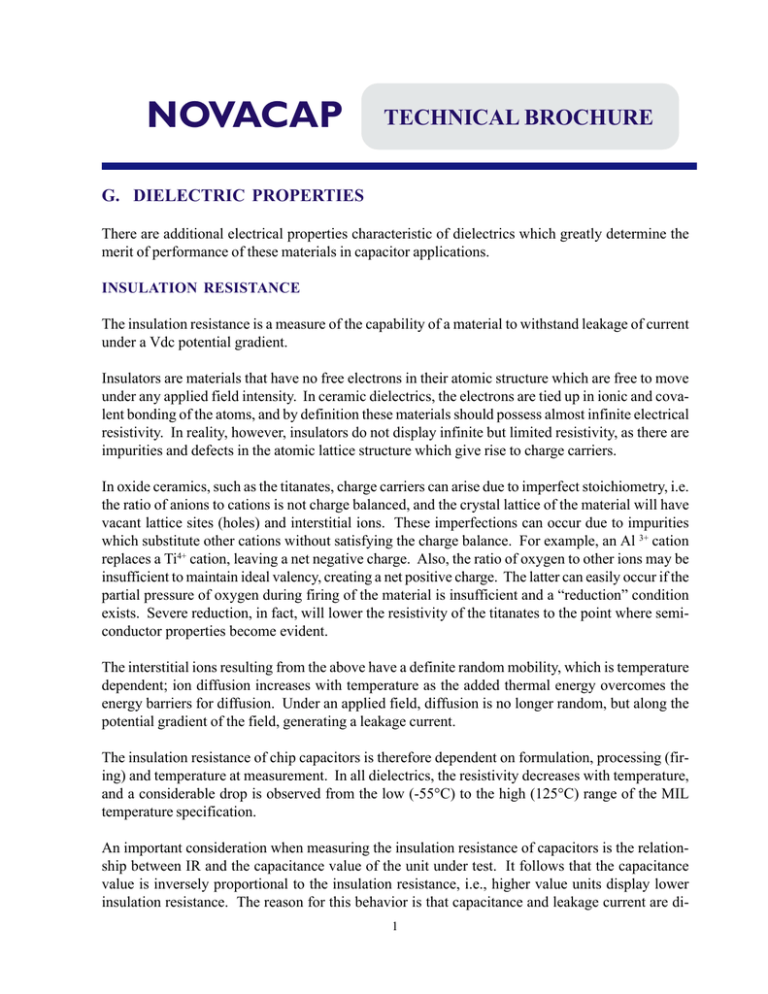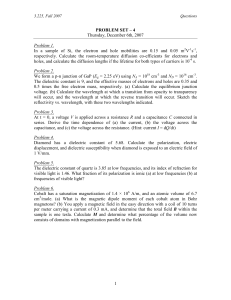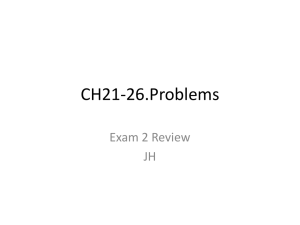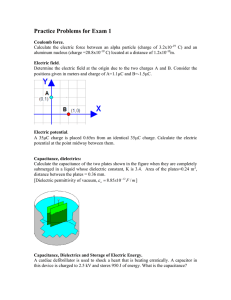Dielectric Properties
advertisement

NOVACAP TECHNICAL BROCHURE G. DIELECTRIC PROPERTIES There are additional electrical properties characteristic of dielectrics which greatly determine the merit of performance of these materials in capacitor applications. INSULATION RESISTANCE The insulation resistance is a measure of the capability of a material to withstand leakage of current under a Vdc potential gradient. Insulators are materials that have no free electrons in their atomic structure which are free to move under any applied field intensity. In ceramic dielectrics, the electrons are tied up in ionic and covalent bonding of the atoms, and by definition these materials should possess almost infinite electrical resistivity. In reality, however, insulators do not display infinite but limited resistivity, as there are impurities and defects in the atomic lattice structure which give rise to charge carriers. In oxide ceramics, such as the titanates, charge carriers can arise due to imperfect stoichiometry, i.e. the ratio of anions to cations is not charge balanced, and the crystal lattice of the material will have vacant lattice sites (holes) and interstitial ions. These imperfections can occur due to impurities which substitute other cations without satisfying the charge balance. For example, an Al 3+ cation replaces a Ti4+ cation, leaving a net negative charge. Also, the ratio of oxygen to other ions may be insufficient to maintain ideal valency, creating a net positive charge. The latter can easily occur if the partial pressure of oxygen during firing of the material is insufficient and a “reduction” condition exists. Severe reduction, in fact, will lower the resistivity of the titanates to the point where semiconductor properties become evident. The interstitial ions resulting from the above have a definite random mobility, which is temperature dependent; ion diffusion increases with temperature as the added thermal energy overcomes the energy barriers for diffusion. Under an applied field, diffusion is no longer random, but along the potential gradient of the field, generating a leakage current. The insulation resistance of chip capacitors is therefore dependent on formulation, processing (firing) and temperature at measurement. In all dielectrics, the resistivity decreases with temperature, and a considerable drop is observed from the low (-55°C) to the high (125°C) range of the MIL temperature specification. An important consideration when measuring the insulation resistance of capacitors is the relationship between IR and the capacitance value of the unit under test. It follows that the capacitance value is inversely proportional to the insulation resistance, i.e., higher value units display lower insulation resistance. The reason for this behavior is that capacitance and leakage current are di1 NOVACAP TECHNICAL BROCHURE rectly proportional to one another, as can be demonstrated using Ohm’s Law and the relationship of capacitance to geometry: Ohm’s Law states that the current (I) in a conductor is related to the applied voltage (V) and the resistance (R) of the conductor as: I = V/R The resistance (R), however, is a dimensionally dependent property, and is related to the intrinsic resistivity of the material (p) as follows: R = pL/A where L = the length of the conductor A = the cross sectional area of the conductor The current (I), therefore, can be expressed as: I = VA/pL When considering a ceramic capacitor, the leakage current (i) through the insulator can be expressed as in the above formula: i = VA’/pt where V = test voltage A’= active electrode area p = dielectric resistivity t = dielectric thickness As is evident from the above relationship, for any given test voltage (V), the leakage current is directly proportional to the active electrode area of the capacitor, and is inversely proportional to the thickness (and resistivity) of the dielectric layer, i.e., i α A’/t Similarly, the capacitance (C) is directly proportional to the active electrode area, and inversely proportional to the dielectric thickness, for C = KA’/4.452 t, where K = dielectric constant A’ = Active electrode area t = dielectric thickness 2 NOVACAP TECHNICAL BROCHURE Hence C α A’/t, and i α C The leakage current (i) is the inverse of the insulation resistance, such that: IR α 1/C Based on the above, certain obvious generalizations apply: The insulation resistance is a function of the test voltage, as leakage current is directly proportional to the applied voltage: i = VA’/pt, or I R = pt/VA’ For any given capacitor, the insulation resistance is largely dependent on the resistivity (p) of the dielectric, which is a property of the material, dependent on formulation, and temperature of measurement, as described previously. The measured IR is inversely proportional to the capacitance value of the unit under test, i.e., IR is a function of capacitance, and hence minimum standards for IR in the industry are established as the product of the resistance (R) and the capacitance (C), (RxC), as shown in Table G-1. EIA specifications require that the RxC product exceed 1000 Ohm-Farad (often expressed as 1000 Megohm-Microfarad) at 25°C, and 100 Ohm-Farad at 125°C, (10% of the values of Table G-1). Dielectrics normally have very high electrical resistance and measurements are reported in large multiples of the Ohm: 1 Tera-ohm (TΩ) 1 Giga-ohm (GΩ) 1 Mega-ohm (MΩ) = 1012 Ohm = 109 Ohm = 106 Ohm In addition to the material and geometric variables, there are other physical factors which influence the insulation resistance of capacitors. Surface Resistivity: The surface of the dielectric may possess different resistivity than the bulk material, due to absorbed impurities, or water moisture. Defects: Dielectric formulations are polycrystalline ceramic aggregates, containing grain 3 NOVACAP TECHNICAL BROCHURE boundaries and pore volume in their microstructure which decrease the intrinsic resistivity of the material. Statistically, the occurrence of these physical defects is directly proportional to chip volume and the complexity of its structure. It follows therefore that larger units, or larger electrode plate area and more numerous electrode layers, may possess a lower resistivity and thus lower insulation resistance than predicted for smaller devices. TABLE G-1 MINIMUM IR STANDARDS VS. CAPACITANCE Capacitance 0.1 pF to .010 µF .015 .022 .033 .047 .068 .100 .150 .220 .330 .470 .680 1.00 etc. Min IR (GΩ) Min RxC (ΩF) @ 25°C 100.00 66.67 45.45 30.30 21.28 14.71 10.00 6.67 4.55 3.03 2.13 1.47 1.00 etc. 1000 DIELECTRIC STRENGTH The dielectric strength is a measure of the ability of the material to withstand a large field strength without electrical breakdown, and is usually expressed in volts per mil (.001') or volts per cm of dielectric. Dielectric failure occurs in insulators when the applied field reaches a threshold point where the restoring forces within the crystal lattice are overcome and a field emission of electrons occurs, generating sufficient number of free electrons which on collision create an avalanche effect and results in a sudden burst of current which punctures the dielectric. In addition to this electric type of failure, high voltage stress creates heat, which lowers the resistivity of the material to the point, where, with sufficient time, a leakage path may develop through the weakest portion of the dielectric. This type of thermal failure is of course temperature dependent, and dielectric strength decreases with temperature. 4 NOVACAP TECHNICAL BROCHURE The intrinsic dielectric strength of any insulator is diminished by physical defects in the microstructure of the material, and, as with insulation resistance, a dependency on geometry is observed with actual measurements. Dielectric strength is inversely proportional to dielectric thickness, as increased volume of the material increases the probability of random defects, as illustrated in Figure G-1. FIGURE G - 1 DIELECTRIC STRENGTH VS. DIELECTRIC THICKNESS Volts/Mil small unit 1200 600 large unit 2.0 4.0 6.0 8.0 dielectric thickness Similarly, dielectric strength is inversely proportional to the electrode layer count of a chip capacitor and to its physical size. Chip capacitors are designed with a margin of safety based on the above considerations, to preclude failure in use and at the dielectric withstanding voltage test, which typically is 2.5 times the working voltage of the device. AGING Ceramic capacitors made with ferroelectric formulations display a decay of capacitance and dielectric loss with time. This phenomenon, called aging, is reversible and occurs due to the crystallographic changes of ferroelectrics with temperature. The ferroelectric group of dielectrics is based on barium titanate (BaTiO3) as the main constituent, an oxide which undergoes changes in crystal habit or symmetry that give rise to ferroelectric domains. At the Curie Temperature of 120°C, BaTiO3 transforms from a tetragonal to a cubic crystal habit, and spontaneous polarization no longer occurs. On cooling through and below the Curie point, the material again transforms from a cubic to a tetragonal crystal configuration in which the lattice has no center of symmetry and the Ti4+ cation can occupy one of two asymmetrical sites, giving rise to a permanent electric dipole. These dipoles form spontaneously and are somewhat ordered, as adjacent unit cells influence one another sufficiently to interact and create domains of 5 NOVACAP TECHNICAL BROCHURE similar polarity. The domains of parallel electrical polarity are random in orientation (without the influence of an electric field) and impart a certain strain energy to the system. The relaxation of this strain energy is attributed to be the mechanism of aging of the dielectric constant, and is found to have the following relationship with time: K = Ko-m log t where K = dielectric constant at any time t Ko = dielectric constant at time t,(to<t) m = rate of decay The above relationship is logarithmic, and data will approximate a straight line when plotted on semilog paper as illustrated in Figure G-2. The percent change of K (or capacitance) per decade can be calculated and used as a figure of merit for dielectric formulations. The microstructure details which affect polarization (material purity, grain size, sintering, grain boundaries, porosity, internal stresses) also determine freedom of domain wall movement and reorientation, and it is found that the aging rate is composition and process dependent and is sensitive to variables which also influence the dielectric constant of the material. FIGURE G -2 FERROELECTRIC AGING % ∆C 0 -5 -10 -15 (a) (b) 10 102 103 104 105 106 hours Example (a) Example (b) Aging Rate = -5% / 5 decades = 1.0%/decade hr. Aging Rate = -15% / 6 decades = 2.5%/decade hr. The loss of capacitance with time is unavoidable with ferroelectric formulations, although it can be reversed by heating the dielectric above the Curie Point and reverting the material back to a “paraelectric” cubic state. On cooling, however, spontaneous polarization will again occur as the material transforms to the tetragonal crystal habit, and new domains recommence the aging process. 6 NOVACAP TECHNICAL BROCHURE As is expected, no aging is observed only in paraelectric formulations, such as NPO, which do not possess the mechanism of spontaneous polarization. The rate at which aging may occur can be influenced by “voltage conditioning” of capacitors. It is found that units stressed by a dc voltage at elevated temperature (below the Curie Point) will experience a loss of capacitance, but with a consequently lower aging rate. It is theorized that the voltage stress at the elevated temperature accelerates the domain relaxation process. This voltage conditioning effect is, of course, eliminated if the unit ever experiences temperatures exceeding the Curie Point. Capacitor manufacturers compensate for capacitance loss of ferroelectric dielectrics by adjustment of the testing limits, such that units do not age out of tolerance over a long time period. For example, for a dielectric with a 1.5%/decade aging rate, the testing limits are raised 3%, i.e. two decades of time. Units tested 100 hours after last exposure to the Curie Temperature therefore will remain within tolerance for another two decades or 10,000 hours. ELECTRO-MECHANICAL COUPLING Dielectric materials always display an elastic deformation when stressed by an electric field, due to displacements of ions within the crystal lattice. The mechanism of polarization, i.e. the shifting of ions in the direction of an applied field, results in a constriction of surrounding ions in the atomic lattice, as restoring forces between atoms strive to balance the system. This behavior is called electrostriction, and is common to all crystals endowed with a center of symmetry. Electrostriction is a one-sided relationship, in that an electric field causes deformation, but an applied mechanical stress does not induce an electric field, as charged centers are not displaced. Piezoelectric materials are those which display a two-sided relationship of mechanical stress and polarization, which is attributed to crystal lattice configurations which lack a center of symmetry. Upon compression, the centers of charge shift and produce a dipole moment, resulting in polarization. This effect is a true linear coupling, as the elastic strain observed is directly proportional to the applied field intensity, and the polarization obtained is directly proportional to the applied mechanical stress. As explained previously in paragraph G-3, barium titanate, the major constituent of ferroelectric dielectrics, lacks a center of symmetry in the crystal lattice at temperatures below the Curie Point (120°C). The material therefore is piezoelectric in nature. When heated past the Curie Temperature, the crystal lattice changes from the tetragonal to the cubic configuration, which possesses a center of symmetry and piezoelectric effects are no longer observed. 7 NOVACAP TECHNICAL BROCHURE DIELECTRIC ABSORPTION Dielectric absorption is the measurement of a residual charge on a capacitor after discharge, and is expressed as the percent ratio of the residual voltage to the initial charge voltage. The residual voltage, or charge, is attributed to the relaxation phenomena of polarization. As explained in paragraph F-2, the polarization mechanisms can lag the applied field. The inverse situation, whereby there is a lag on depolarization, or discharge, also applies. A small fraction of the polarization, in fact, may persist after discharge for long time periods, and can be measured on the device with a high impedance voltmeter. Dielectrics with higher dielectric constant, and, therefore more polarizing mechanisms, typically display more dielectric absorption than lower K materials. 8



